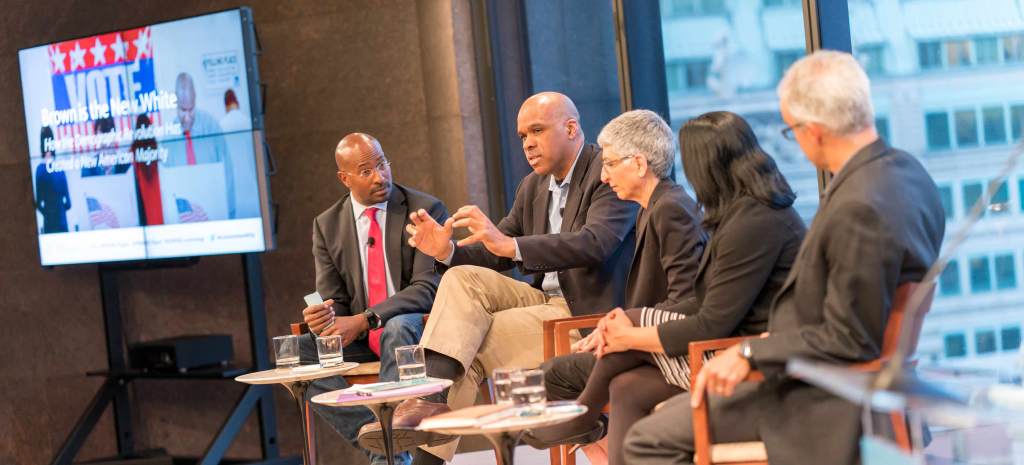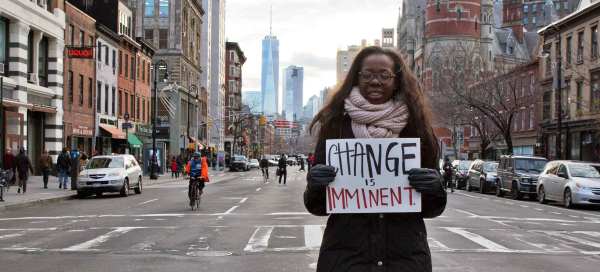
The United States is undergoing rapid demographic change: By 2043 it will become a majority-minority country, with no single ethnic or racial group making up the majority population. But according to political leader and civil rights lawyer Steve Phillips’s new book, Brown is the New White: How the Demographic Revolution has created a New American Majority, we already have a new majority, one that consists of progressive people of color and progressive whites. This new American majority makes up 51 percent of the population and, Phillips argues, has the potential to change election outcomes.
Yet despite the clear value of having the support of people of color, the Democratic and Republican parties have both done surprisingly little to engage these voters. Instead, both parties have focused on winning over white swing voters, even as this has proved time and again to be an ineffective strategy.
The Ford Foundation recently brought Steve Phillips together with other experts to discuss America’s changing racial demographics and the impact they have on elections and the political process. Here are highlights from that conversation.
There’s no going back: America is a multiracial country
During this election season, questions of identity, race, ethnicity, and religion have become more urgent than ever, and we’ve seen political leaders use race to divide communities when it comes to what it means to be a “real” American. During the discussion, Steve Phillips pointed out that for centuries, favoring whites has led to an unequal distribution of wealth and opportunities between racial groups. The fundamental question for political parties and the country in general, Phillips argues, is whether to embrace the reality of American diversity to build a more inclusive society, or try to turn the clock back to a time when only white, Christian, heterosexual men were considered American citizens.
Accessibility Statement
- All videos produced by the Ford Foundation since 2020 include captions and downloadable transcripts. For videos where visuals require additional understanding, we offer audio-described versions.
- We are continuing to make videos produced prior to 2020 accessible.
- Videos from third-party sources (those not produced by the Ford Foundation) may not have captions, accessible transcripts, or audio descriptions.
- To improve accessibility beyond our site, we’ve created a free video accessibility WordPress plug-in.
Both political parties must address issues that matter to people of color, and it’s up to social movements to put pressure on them
Deepa Iyer, author and senior fellow at the Center for Social Inclusion, doesn’t think that either political party is doing a good job of speaking to people of color and addressing the issues that matter to them most. She stressed the importance of social movements in holding politicians accountable:, how, for example, pressure from the immigrant rights movement played a crucial role in getting the Obama administration to take on immigration reform, and how the movement for black lives has increasingly made it difficult for politicians to avoid addressing issues like criminal justice and police brutality. “We need to invest in and support movements in order to push the political parties to actually respond to us,” Iyer urged.
Accessibility Statement
- All videos produced by the Ford Foundation since 2020 include captions and downloadable transcripts. For videos where visuals require additional understanding, we offer audio-described versions.
- We are continuing to make videos produced prior to 2020 accessible.
- Videos from third-party sources (those not produced by the Ford Foundation) may not have captions, accessible transcripts, or audio descriptions.
- To improve accessibility beyond our site, we’ve created a free video accessibility WordPress plug-in.
Brown swing voters are the future
Traditionally, the vast majority of people of color have voted for Democrats. As a result, the Democratic Party takes black and brown voters for granted, while the Republicans have tended to ignore these communities all together. Tamar Jacoby, president and CEO of Opportunity America, pointed out that it’s important for both parties to see the votes of people of color as variable. “We’ll never get to real answers unless we live in a world where people are looking at people of color as swing voters,” she said. She emphasized that a competitive Republican Party has the potential to appeal to voters of color, noting the danger that without real alternatives, progressives will continue business as usual and just assume people of color are on their side.
Accessibility Statement
- All videos produced by the Ford Foundation since 2020 include captions and downloadable transcripts. For videos where visuals require additional understanding, we offer audio-described versions.
- We are continuing to make videos produced prior to 2020 accessible.
- Videos from third-party sources (those not produced by the Ford Foundation) may not have captions, accessible transcripts, or audio descriptions.
- To improve accessibility beyond our site, we’ve created a free video accessibility WordPress plug-in.
We must refuse to be divided by color or immigration status
Ian Haney López, author and law professor at the University of California, Berkeley, pointed out that the Democrats’ are reluctant to talk about race for fear of losing white voters to Republicans. But in order to build a progressive coalition, he said, it is crucial to combine policies and visions that speak to people of color and whites alike. The way forward is to realize that “we are all in this together, whatever our color,” Haney López said.
Accessibility Statement
- All videos produced by the Ford Foundation since 2020 include captions and downloadable transcripts. For videos where visuals require additional understanding, we offer audio-described versions.
- We are continuing to make videos produced prior to 2020 accessible.
- Videos from third-party sources (those not produced by the Ford Foundation) may not have captions, accessible transcripts, or audio descriptions.
- To improve accessibility beyond our site, we’ve created a free video accessibility WordPress plug-in.
Watch the full event:
Accessibility Statement
- All videos produced by the Ford Foundation since 2020 include captions and downloadable transcripts. For videos where visuals require additional understanding, we offer audio-described versions.
- We are continuing to make videos produced prior to 2020 accessible.
- Videos from third-party sources (those not produced by the Ford Foundation) may not have captions, accessible transcripts, or audio descriptions.
- To improve accessibility beyond our site, we’ve created a free video accessibility WordPress plug-in.
